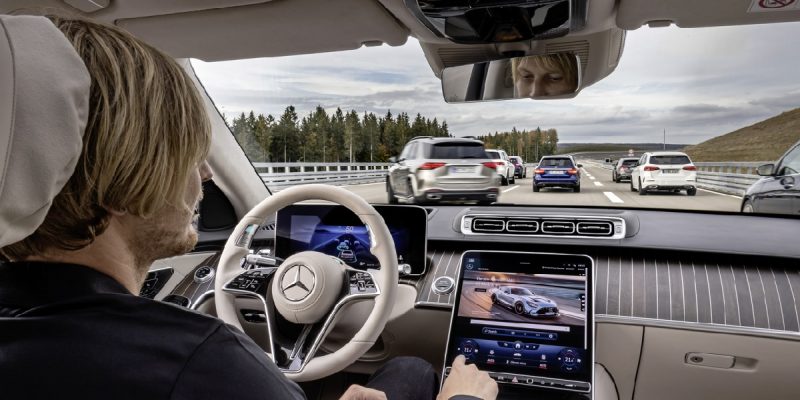Mercedes-Benz is claiming to be the first automaker to meet the legal requirements to run a fully approved Level 3 autonomous driving system.
The German Federal Motor Transport Authority (KBA) has granted system approval for this on the basis of the technical approval regulation UN-R157, paving the way to offer the technology on its global products where local regulations allow. This move is part of Germany’s push to spearhead the advancement of driverless technology as retired Chancellor Angela Merkel had outlined during the IAA Munich in September.
Now customers will be able to buy an S-Class with DRIVE PILOT in the first half of 2022, allowing them to drive in conditionally automated mode at speeds of up to 50mph in heavy traffic or congested situations on suitable stretches of motorway in Germany. The system allows drivers to perform ancillary tasks on the central display such as online shopping or processing e-mails in the in-car office. The system approval also applies to the EQS.
The technical approval regulation with which such a system can be certified did not come into force until the beginning of 2021. With the opening of the Road Traffic Act (StVG) for Level 3 systems in 2017, Germany was the first country to create a legal basis for the intended use of these systems.
Mercedes-Benz is initially offering DRIVE PILOT on 8,200 miles of highway in Germany with test drives for the system are already underway, for example in the US and China. As soon as there is a national legal framework for conditionally automated operation in additional markets, the technology will be rolled out further.
On suitable road sections and where traffic density is high, the system claims to take over the driving, initially up to the legally permitted 50mph. The controls needed for this are located in the steering wheel rim, on the left and right above the thumb recesses. When the driver activates it, the system controls the speed and distance, while guiding the vehicle within its lane. The route profile, events occurring on the route and traffic signs are correspondingly taken into consideration. The system also reacts to unexpected traffic situations and handles them independently, such as braking and evasion maneuvers.
The system builds on the surround sensors of the Driving Assistance Package and comprises additional sensors such as LiDAR, as well as a camera in the rear window and microphones, especially for detecting blue lights and other special signals from emergency vehicles, as well as a wetness sensor in the wheel well.
On top of the sensor data, the system receives information about the road geometry, route profile, traffic signs and unusual traffic events (e.g. accidents or roadworks) from a digital HD map. This is made available and updated via a backend connection. The S-Class with the optional technology also has redundant steering and braking systems and a redundant on-board electrical system, so that it remains maneuverable even if one of these systems fails and the safe handover to the driver can be ensured.
If the driver fails to take back control even after increasingly urgent prompting and expiry of the takeover time, perhaps owing to a health problem, the system brakes the vehicle to a standstill in a controlled manner and with suitable deceleration. At the same time the hazard warning lights and, once the vehicle has come to a standstill, the Mercedes-Benz emergency call system is activated and the doors and windows are unlocked, to make access to the interior easier for any first responders.
Markus Schäfer, chief technology officer responsible for development and purchasing for both Daimler and Mercedes-Benz, said: “For many years, we have been working to realize our vision of automated driving. With this LiDAR based system, we have developed an innovative technology for our vehicles that offers customers a unique, luxurious driving experience and gives them what matters most: time. With the approval of the authorities, we have now achieved a breakthrough: We are the first manufacturer to put conditionally automated driving into series production in Germany. With this milestone, we are once again proving our pioneering work in automated driving and also initiating a radical paradigm shift. For the first time in 136 years of automotive history, the vehicle takes over the dynamic driving task under certain conditions. At the same time, we are pleased that Germany is continuing its pioneering role in automated driving with this approval.”
— Paul Myles is a seasoned automotive journalist based in Europe. Follow him on Twitter @Paulmyles_
by Paul Myles
Source: https://www.tu-auto.com




